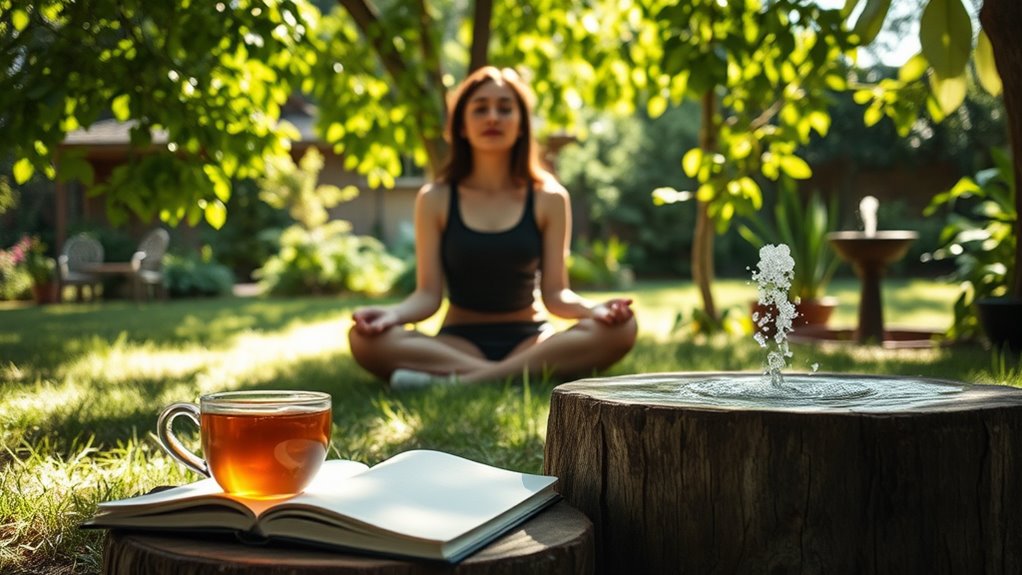How to Find Peace With Just 5 Minutes of Breathing!
You can find peace in just five minutes of focused breathing. Start by choosing a calming space and use a technique like the 4-7-8 method: inhale for four seconds, hold for seven, and exhale for eight. Feel your body relax as you bring awareness to your breath. Regular practice reduces stress and increases clarity, boosting your overall well-being. Make this a daily habit, perhaps setting aside a specific time or pairing it with other routine tasks. With just a few minutes, you can reclaim your inner calm. There’s so much more to discover about enhancing your practice!
Key Takeaways
- Dedicate 5 minutes daily to focused breathing techniques like the 4-7-8 or diaphragmatic breathing for immediate calm and clarity.
- Create a serene environment by eliminating distractions and incorporating calming colors and soothing sounds.
- Use reminders like sticky notes or phone alarms to prompt your daily breathing practice.
- Pair your breathing exercises with routine activities, making it easier to integrate into your day.
- Regular practice enhances emotional resilience, reduces stress, and transforms overall well-being.
Understanding the Importance of Breathing
Breathing is more than just a vital function; it’s a powerful tool for achieving peace and balance in your life. When you cultivate breath awareness, you tap into a profound resource that can transform your emotional and physical well-being. Each breath you take is an opportunity to ground yourself, to reconnect with the present moment, and to release the stress that’s built up inside you.
In our fast-paced world, stress can easily overwhelm you, but understanding the importance of your breath can pave the way for effective stress reduction. By simply directing your attention to your breathing, you initiate a calming response in your body. This practice not only lowers your heart rate but also encourages clarity and focus, helping you navigate challenges with a clear mind.
You don’t need to wait for the perfect moment; you can start right now. Embrace breath awareness as your ally. Every intentional breath draws you closer to tranquility, allowing you to reclaim your inner peace. Remember, mastery comes with practice, so make it a daily commitment. Your breath is your anchor—hold onto it and watch how it transforms your experience of stress and life.
Simple Breathing Techniques to Try
Numerous simple breathing techniques can help you find calm and clarity in your daily life. One effective method is the 4-7-8 technique. Start by inhaling deeply through your nose for a count of four, ensuring you engage in mindful inhalation. Hold your breath for seven seconds, then exhale slowly through your mouth for a count of eight, focusing on a deliberate and relaxed exhalation.
Another technique is the box breathing method. Inhale through your nose for four counts, hold for four, exhale for four, and pause for four before repeating. This rhythmic approach encourages a sense of control and balance.
You might also try diaphragmatic breathing. Place one hand on your chest and the other on your abdomen. Inhale deeply through your nose, letting your abdomen rise while keeping your chest still. Exhale fully, allowing your abdomen to fall, promoting a focused exhalation.
Incorporate these techniques into your daily routine, even if just for five minutes. With practice, you’ll cultivate a deeper sense of mastery and peace, allowing you to navigate life’s challenges with greater ease. Remember, consistency is key to harnessing the power of your breath.
Creating a Peaceful Environment
Finding peace isn’t just about mastering breathing techniques; it also involves creating a supportive environment around you. To enhance your breathing practice, consider how your surroundings affect your state of mind. By intentionally selecting calming colors and incorporating soothing sounds, you can transform your space into a sanctuary for relaxation.
Here’s a simple guide to help you curate your peaceful environment:
| Element | Suggestions |
|---|---|
| Calming Colors | Soft blues, gentle greens, pastel hues |
| Soothing Sounds | Nature sounds, soft instrumental music, white noise |
Make sure to eliminate clutter and distractions. A clean space allows for a clear mind, making it easier for you to focus on your breath. You might also want to introduce elements of nature, like plants or natural light, which can further enhance tranquility.
Incorporating Breathing Into Your Day
Incorporating breathing techniques into your daily routine can be a game-changer for managing stress and enhancing your overall well-being. Start by setting aside just five minutes each day for focused breathing. You can do this first thing in the morning, during lunch, or before bedtime—whenever it fits best into your schedule.
To help you remember, create daily reminders that prompt you to pause and breathe. Use sticky notes, phone alarms, or even a mindfulness app. These mindful moments not only ground you but also serve as a powerful reset throughout your busy day.
As you practice, try different techniques, like deep belly breathing or box breathing, to see what resonates with you. Over time, you’ll find that these moments of intentional breathing become a natural part of your routine.
You might also consider pairing your breathing exercises with daily activities. For instance, take a few deep breaths while waiting in line or during a brief break at work. By weaving these practices into your life, you’ll cultivate a sense of calm and focus that enhances your overall mastery of well-being.
Benefits of Regular Breathing Practice
Embracing a regular breathing practice can significantly impact your mental and physical health. By dedicating just a few minutes each day to focused breathing, you open the door to a multitude of breathing benefits. You’ll notice an immediate sense of calm and clarity that can enhance your daily life.
One of the most profound advantages is stress reduction. As you engage in deep, intentional breaths, your body activates the relaxation response, which counteracts the fight-or-flight instinct. This process reduces cortisol levels, allowing you to navigate challenges with greater ease and composure.
Moreover, regular breathing exercises improve your lung capacity and oxygenate your body more efficiently, boosting your energy levels. You’ll feel more alert and present, empowering you to tackle your goals.
Incorporating breathing techniques into your routine also fosters emotional resilience. You’ll cultivate a greater awareness of your thoughts and feelings, enabling you to respond thoughtfully rather than react impulsively.
As you commit to this practice, you’re not just breathing; you’re transforming your well-being. So, take that first step, and experience the enriching benefits of a consistent breathing practice. Your journey toward peace and mastery begins now!
Frequently Asked Questions
Can Breathing Techniques Help With Anxiety and Stress Management?
Imagine a balloon inflating and deflating. Just like that balloon, your breath can bring anxiety relief. Breathing techniques offer powerful benefits, helping you manage stress and regain control. Give yourself those moments to breathe deeply.
How Often Should I Practice Breathing Exercises for Best Results?
To achieve optimal results, practice breathing exercises daily for at least five minutes. This frequency builds mastery, helping you manage stress effectively. Consistency is key, so make it a part of your routine!
Are There Any Specific Times of Day Best for Breathing Exercises?
Morning routines and evening rituals are prime times for practicing breathing exercises. Starting your day with calmness and closing it with clarity not only enhances focus but also fosters a fulfilling, peaceful mindset. Embrace the balance!
Can Children Benefit From Breathing Techniques as Well?
Absolutely! Children can benefit immensely from breathing techniques. Incorporating children’s mindfulness through fun breathing games not only helps them relax but also enhances their focus, emotional regulation, and overall well-being. You’re nurturing their growth!
What Should I Do if I Feel Lightheaded During Breathing Exercises?
If you feel lightheaded during breathing exercises, it’s important to recognize that lightheadedness causes can vary. Try slowing your breath and focusing on grounding techniques; these coping strategies can help you regain balance and confidence.



